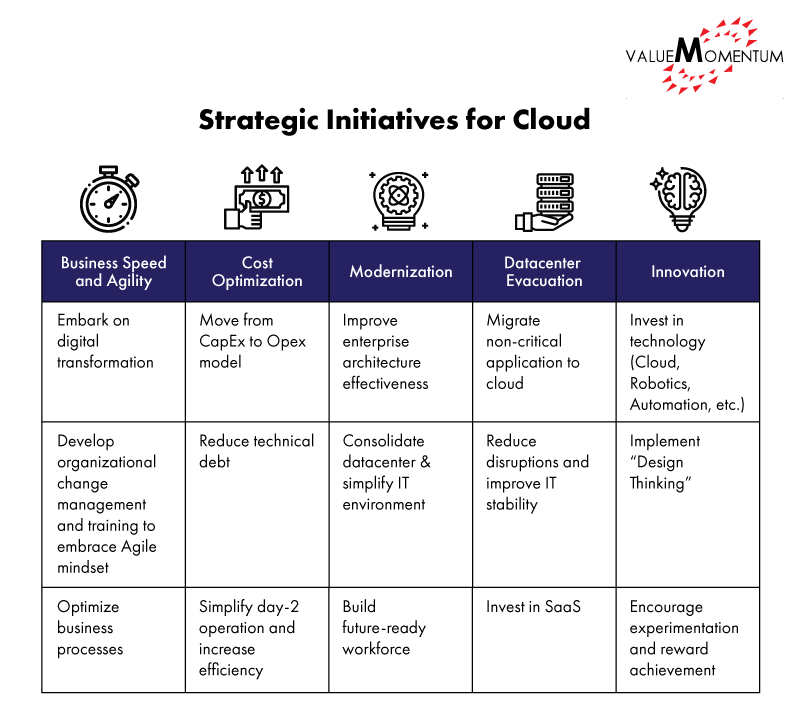The race for cloud adoption in the insurance industry has begun, but success depends on not only speed, but also strategy. Whether you’ve already begun your cloud journey, or are still at the starting line, a well-thought out roadmap that clearly aligns your business and IT efforts is crucial.
Insurers at any stage of cloud adoption can benefit from an assessment. For this assessment to be successful, however, insurers must first clearly define the business objectives of their cloud journey. This is essential for creating the critical alignment between your technology and enterprise, as well as for determining the best approach and key initiatives your organization needs to undergo.
To help get you started, we’ve identified five main business objectives that drive insurers towards cloud, and the key initiatives that insurers can undertake to support these business objectives.
The first step to successful cloud adoption in insurance is defining your business objective
Though many insurers will discover that more than one business objective is driving their cloud adoption, it is necessary to prioritize which objectives are most relevant to your larger enterprise. Doing so will narrow the scope of your project and allow for resources to be leveraged more efficiently and effectively.
- Business Speed and Agility
Some insurers are leveraging cloud primarily for its ability to significantly reduce time-to-market and enable speedy delivery of IT products. Cloud can accelerate your product development lifecycle, thus enabling your business to quickly address and respond to shifting customer demands. - Cost Optimization
Cloud computing’s flexible pay-per-use model and low cost of entry is appealing for insurers who prioritize cost optimization. With cloud, you can leverage a range of providers, platforms, and cutting-edge tools that can be quickly scaled up or down as needed. Given the speed in which technology becomes obsolete, cloud also offers significant savings when considering the licensing renewal fees, consulting and installation fees, need for regular IT oversight/update, etc., common to traditional IT solutions. - Modernization
Cloud computing is also being embraced for its ability to standardize system configurations and automate IT support processes. By simplifying and modernizing the IT environment, enterprises can better devote their time and energy to designing market solutions for growth and preparing a future-ready workforce. - Datacenter Evacuation
Some insurers are utilizing cloud as an opportunity to consolidate data in one space, rearchitect their infrastructure to remove data silos, and enable more accessible and intelligent data-driven insights. Moreover, moving some or all of your datacenter to the cloud can safeguard against IT disruptions, since cloud preserves your data in the case that your organization lacks space or power, or when at-risk of outage. - Innovation
With cloud, insurers can reap the benefits of experimentation and design thinking. From machine learning and APIs to predictive analytics and bots, cloud provides advanced tools to design sophisticated customer journeys, deploy new products and services, and gain entry into new markets. If your goal is innovation, investing in cloud can equip you with the technologies and capabilities you need to become a next-generation insurer.
Supporting your cloud strategy and business objectives
Once you have defined your objectives, there are several strategic initiatives you can prioritize to align your cloud strategy to the business and prepare your enterprise for cloud success. Some of these initiatives are directly related to cloud adoption, while for others, this relationship may not be as clearly defined. Nonetheless, these initiatives will go a long way in setting the foundation for a successful journey to cloud.
The table below shoes some key initiatives insurers can act on for the business objectives highlighted above.
Next step: Cloud Assessment
After confirming the direction of your cloud journey, the next step is assessing the current state of cloud readiness at your organization. Such an assessment will reveal what has already been done to leverage cloud, whether IT efforts are aligned with your business objectives, and the amount of effort still required moving forward. When it comes to cloud adoption in insurance, defining your business objectives before completing a cloud assessment will equip your organization with the goalposts you need to create (or modify) a roadmap that can carry your entire organization through a successful cloud journey.
For more information on how ValueMomentum can help you advance your cloud journey, visit our Digital & Cloud page.
